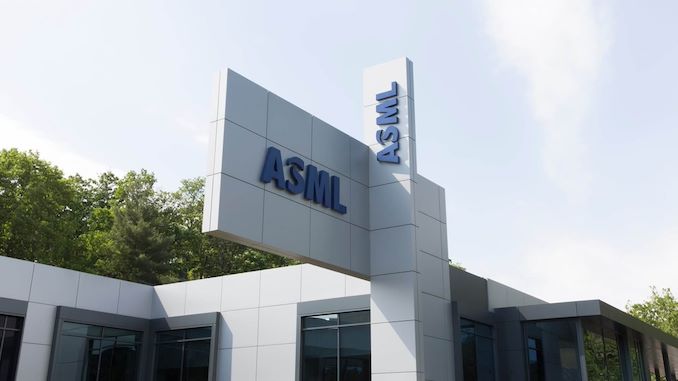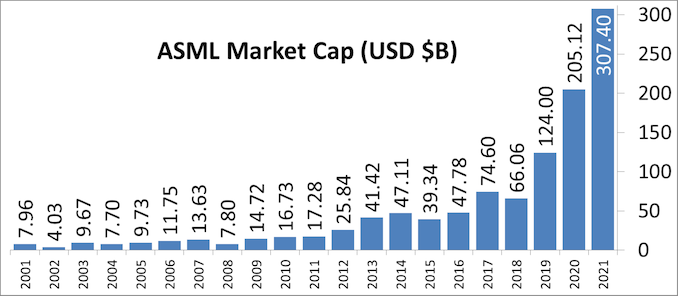Intel's Process Roadmap to 2025: with 4nm, 3nm, 20A and 18A?!
by Dr. Ian Cutress on July 26, 2021 5:00 PM ESTSidebar on Intel EUV
In all of these announcements, one thing to highlight is Intel mentioning its relationship with ASML, the sole company that manufactures the EUV machines powering production of leading edge semiconductor manufacturing.
ASML is a unique company in that it is the only one that can produce these machines, because the technology behind them is often tied up with its partners and research, but also because all the major silicon manufacturers are heavily invested in ASML. For any other company to compete against ASML would require building a separate network of expertise, a decade of innovation and design, and a lot of capital. None of the major silicon vendors want to disturb this balance and go off on their own, lest it shuts them out of the latest manufacturing technology, and no research fund sees competing against the embedded norm as a viable opportunity. This means that anyone wanting EUV specialist technology has to go to ASML.
In 2012, it was reported that Intel, Samsung, and TSMC all invested in ASML. This was, at the time, to jumpstart EUV development along with migrating from 300mm wafers to 450mm wafers. While we haven’t moved to 450mm wafers yet (and there are doubts we will any time in the next decade), EUV is now here. Intel’s 2012 investment of $2.1 billion gave them a 10% stake in ASML, with Intel stating that it would continue investing up to a 25% stack. Those stakes are now below the 5% reporting threshold, but all three of the major foundry customers are still big owners, especially as ASML’s market cap has risen from $24 Billion in 2012 to $268 Billion in 2021 (surpassing Intel).
As major investors but also ASML’s customers, the race has been on for these foundries to acquire enough EUV machines to meet demand. TSMC reported in August 2020 that it has 50% of all EUV machines manufactured at ASML for its leading edge processes. Intel is a little behind, especially as none of Intel’s products in the market yet use any EUV. EUV will only intercept Intel’s portfolio with its new Intel 4 process, where it will be used extensively, mostly on the BEOL. But Intel still has to order machines when they need them, especially as there are reports that ASML currently has backorders of 50 EUV machines. In 2021, ASML is expected to manufacture around 45-50 machines, and 50-60 in 2022. The exact number of machines Intel has right now, or has ordered from ASML, is unknown. It is expected that each one has a ~$150m price tag, and can take 4-6 months to install.
With all that being said, Intel’s discussion point today is that it will be the lead customer for ASML’s next generation EUV technology known as High-NA EUV. NA in this context relates to the ‘numerical aperture’ of the EUV machine, or to put simply, how wide you can make the EUV beam inside the machine before it hits the wafer. The wider the beam before you hit the wafer, the more intense it can be when it hits the wafer, which increases how accurately the lines are printed. Normally in lithography to get better printed lines, we move from single patterning to double patterning (or quad patterning) to get that effect, which decreases yield. The move to High-NA would mean that the ecosystem can stay on single patterning for longer, which some have quoted as allowing the industry to ‘stay aligned with Moore’s Law longer’.
| ASML's EUV Shipments | |||||||||||||||||||||
| 2015 | 2016 | 2017 | 2018 | 2019 | 2020 | 2021 | |||||||||||||||
| Actual | 2 | 4 | 10 | 3 | 4 | 5 | 6 | 4 | 7 | 7 | 8 | 4 | 7 | 14 | 8 | 7 | 9 | - | - | ||
| Target (Total) | - | - | - | 20 (18) | 30 (26) | 35 (33) | 45-50 | ||||||||||||||
| 2018 and beyond is split per quarter for actual shipped numbers Data taken from ASML's Financial Reports |
|||||||||||||||||||||
Current EUV systems are NA 0.33, while the new systems are NA 0.55. ASML’s latest update suggests that it expects customers to be using High-NA for production in 2025/2026, which means that Intel is likely going to be getting the first machine (ASML NXE:5000 we think) in mid-2024. Exactly how many High-NA machines ASML intends to produce in that time frame is unknown, as if they flood the market, having the first won’t be a big win. However if there is a slow High-NA ramp, it will be up to Intel to capitalize on its advantage.













326 Comments
View All Comments
alufan - Tuesday, July 27, 2021 - link
Lol is all just LolSeems Anandtech is still swallowing all Intels Bull
so a 4 is not 4nm but is actually 7nm!
You just know they are failing at producing decent CPUs at up to date processes when they think of a ruse like this to slap on machines in store to make the non Techies of the world swallow the pill intel is lower so must therefore be better, shame on you Anandtech for not calling this what it is an Intel crap sandwich
mode_13h - Wednesday, July 28, 2021 - link
> when they think of a ruse like this to slap on machines in storeNobody ever said they're using this in retail branding! No, they already have BS numbering schemes for that, with i3/i5/i7/i9 and Nth generation.
These names are mostly for foundry customers, and also those tech insiders who even know what a manufacturing process is.
dicobalt - Tuesday, July 27, 2021 - link
When I started reading I automatically assumed this meant Intel is going to lie about the process just like everyone else is. Then I saw that I was right. Maybe Intel should be using density as they have suggested before instead of lying like everyone else. There's also the most real life relevant performance per dollar metric too. Intel should be setting standards that people can use not playing a stupid marketing game with the coke addled wallstreet gimps.mode_13h - Wednesday, July 28, 2021 - link
Manufacturers never *want* to use real metrics. Maybe when their products are head-and-shoulders above everyone else, but otherwise not.It's like how hi-fi gear uses A-weighted SNR, when they really should use C-weighted (if they even tell you the SNR, that is). Why do they use A-weighted? Because someone figured they could get better numbers that way and then everyone else had to follow.
But they'd really rather sell on the basis of non-quantifiable things, like Apple is probably most famous for doing. When Apple lists product specs, it's mostly just to upsell its customers vs. other products they're considering or already own. But rarely does someone actually buy Apple because of the specs.
Oxford Guy - Wednesday, July 28, 2021 - link
‘But rarely does someone actually buy Apple because of the specs.’Tell that to all the Mac owners who were forced to buy replacement machines because Apple force-fed them the APFS file system — incompatible with hard drives (unless one counts glacial speeds as evidence of compatibility).
Then, there are the quickly-orphaned iPad 1 owners, orphaned because Apple put so little RAM into them. (That’s Apple’s #1 ploy and has been since 1984.)
Spunjji - Thursday, July 29, 2021 - link
You're still making a pretty solid argument in favour of most Apple owners not buying due to specs. I know a few people who still used iPad 1s until relatively recently (usually as a glorified e-Reader) and really didn't care about the OS not being updated. Most of them only stopped when the devices got physically broken.For most of the people who got screwed by the things you mentioned, it was a surprise because they just didn't think about those specs until they were forced to.
GeoffreyA - Friday, July 30, 2021 - link
"Apple is the best. I'm buying this. Not interested in any of that last-grade Android junk."Oxford Guy - Tuesday, August 3, 2021 - link
Android was quite an inferior experience the last time I used it — and I think a good number of iOS design choices are vile. Just today, for instance, it harassed me with pop ups twice in a row (three times over the course of me writing a single message) — demanding that I turn on dictation. It also popped up a harassment window to order me to enter my Apple ID.So, for Android to be a worse experience than that says what needs to be said about the state of ‘smart’ phones.
mode_13h - Wednesday, August 4, 2021 - link
> for Android to be a worse experience than thatThere's not a singular Android experience. Each phone maker customizes it in varying ways and to varying degrees. Samsung supposedly does heavier customization, among phone makers.
Back when Google had the "Nexus" product line, it was supposed to be mostly unmodified. I'm not sure if their Pixel devices continue that tradition, but it would make sense.
Oxford Guy - Wednesday, August 11, 2021 - link
‘There's not a singular Android experience’Uh huh.